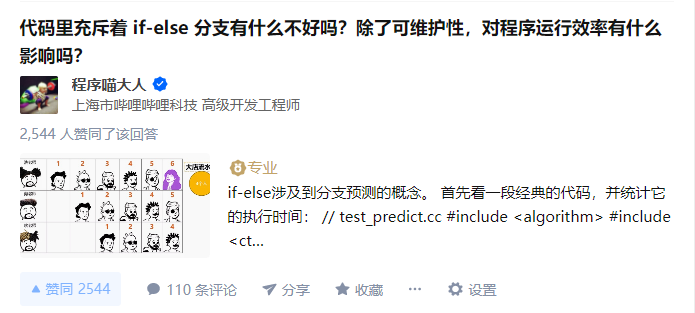满屏的if-else,怎么消灭它们?

之前我曾经在知乎写过一篇回答,详细介绍了if-else的效率问题。

过多的if-else不仅导致程序运行效率低下,而且导致代码圈复杂度过高。如果大家有使用过静态代码分析工具,就会知道圈复杂度是衡量代码质量的一项重要的指标,圈复杂度越高,代码出现bug的可能性也越大。
我们可能刚开始写的代码很简洁,只有一个if-else分支,但由于需求的叠加和各种错误处理,我们有时候不得已要多加几个if-else,久而久之就发现,满屏的if-else,令你极其讨厌自己写的代码。
作者:程序喵大人
来源公众号:程序喵大人
至于如何消灭if-else,可谓八仙过海各显神通,这里介绍几种常见的方法:
巧用表结构:一般如果某些条件可存储,可以考虑把条件存起来用于去掉if-else,例如:
long long func() {const unsigned ARRAY_SIZE = 50000;int data[ARRAY_SIZE];const unsigned DATA_STRIDE = 256;for (unsigned c = 0; c < ARRAY_SIZE; ++c) data[c] = std::rand() % DATA_STRIDE;long long sum = 0;for (unsigned c = 0; c < ARRAY_SIZE; ++c) {if (data[c] >= 128) sum += data[c];}return sum;}
可以通过表结构去掉代码中的if分支
long long func() {const unsigned ARRAY_SIZE = 50000;int data[ARRAY_SIZE];const unsigned DATA_STRIDE = 256;int lookup[DATA_STRIDE];for (unsigned c = 0; c < DATA_STRIDE; ++c) {lookup[c] = (c >= 128) ? c : 0;}for (unsigned c = 0; c < ARRAY_SIZE; ++c) data[c] = std::rand() % DATA_STRIDE;long long sum = 0;for (unsigned c = 0; c < ARRAY_SIZE; ++c) {sum += lookup[data[c]];}return sum;}
使用switch-case替换if-else:一般情况下switch-case比if-else效率高一些,而且逻辑也更清晰,例如:
void func() {if (a == 1) {...} else if (a == 2) {...} else if (a == 3) {...} else if (a == 4) {...} else {...}}
try-catch替换:if-else很多情况下都用于错误处理,如果我们使用try-catch处理错误,是不是就可以消灭if-else了呢,拿数值运算代码举例:
class Number {public:friend Number operator+ (const Number& x, const Number& y);friend Number operator- (const Number& x, const Number& y);friend Number operator* (const Number& x, const Number& y);friend Number operator/ (const Number& x, const Number& y);// ...};
最简单的可以这样调用:
void f(Number x, Number y) {// ...Number sum = x + y;Number diff = x - y;Number prod = x * y;Number quot = x / y;// ...}
但是如果需要处理错误,例如除0或者数值溢出等,函数得到的就是错误的结果,调用者需要做处理。
先看使用错误码的方式:
class Number {public:enum ReturnCode {Success,Overflow,Underflow,DivideByZero};Number add(const Number& y, ReturnCode& rc) const;Number sub(const Number& y, ReturnCode& rc) const;Number mul(const Number& y, ReturnCode& rc) const;Number div(const Number& y, ReturnCode& rc) const;// ...};int f(Number x, Number y){// ...Number::ReturnCode rc;Number sum = x.add(y, rc);if (rc == Number::Overflow) {// ...code that handles overflow...return -1;} else if (rc == Number::Underflow) {// ...code that handles underflow...return -1;} else if (rc == Number::DivideByZero) {// ...code that handles divide-by-zero...return -1;}Number diff = x.sub(y, rc);if (rc == Number::Overflow) {// ...code that handles overflow...return -1;} else if (rc == Number::Underflow) {// ...code that handles underflow...return -1;} else if (rc == Number::DivideByZero) {// ...code that handles divide-by-zero...return -1;}Number prod = x.mul(y, rc);if (rc == Number::Overflow) {// ...code that handles overflow...return -1;} else if (rc == Number::Underflow) {// ...code that handles underflow...return -1;} else if (rc == Number::DivideByZero) {// ...code that handles divide-by-zero...return -1;}Number quot = x.div(y, rc);if (rc == Number::Overflow) {// ...code that handles overflow...return -1;} else if (rc == Number::Underflow) {// ...code that handles underflow...return -1;} else if (rc == Number::DivideByZero) {// ...code that handles divide-by-zero...return -1;}// ...}
再看使用异常处理的方式:
void f(Number x, Number y){try {// ...Number sum = x + y;Number diff = x - y;Number prod = x * y;Number quot = x / y;// ...}catch (Number::Overflow& exception) {// ...code that handles overflow...}catch (Number::Underflow& exception) {// ...code that handles underflow...}catch (Number::DivideByZero& exception) {// ...code that handles divide-by-zero...}
如果有更多的运算,或者有更多的错误码,异常处理的优势会更明显。
提前return:对于某些错误处理可以考虑提前return,直接看代码:
void func(A *a) {if (a) {...} else {log_error(...);return;}}
适当情况下通过反转if条件就可以删除掉else分支。
合并分支表达式:有些情况下可以通过合并表达式来消除if-else,例如:
void func() {if (a < 20) return;if (b > 30) return;if (c < 18) return;}
可以改为
void func() {if (a < 20 || b > 30 || c < 18) return;}
策略模式:熟悉设计模式的同学可能都知道,一般代码中if-else过多,那就可以考虑使用策略模式啦,例如:
enum class CalOperation {add,sub};int NoStragegy(CalOperation ope) {if (ope == CalOperation::add) {std::cout << "this is add operation" << std::endl;} else if (ope == CalOperation::sub) {std::cout << "this is sub operation" << std::endl;} // 如何将来需要增加乘法或者除法或者其它运算,还需要增加if-elsereturn 0;}
这种if-else可以通过策略模式进行消除:
class Calculation {public:Calculation() {}virtual ~Calculation() {}virtual void operation() { std::cout << "base operation" << std::endl; }};class Add : public Calculation {void operation() override { std::cout << "this is add operation" << std::endl; }};class Sub : public Calculation {void operation() override { std::cout << "this is sub operation" << std::endl; }};int Stragegy() {Calculation *cal = new Add();cal->operation();delete cal;Calculation *cal2 = new Sub(); // 这里将来都可以用工厂模式改掉,不会违反开放封闭原则cal2->operation();delete cal2;return 0;}
将来如果有乘法除法和其它运算规则,只需要再加一个继承基类的子类即可。方便扩展,且遵循设计原则。
职责链模式:职责链模式尽管不能消灭if-else,但它可以用于改良if-else,使其更灵活,例如:
using std::cout;void func(int num) {if (num >= 0 && num <= 10) {cout << "0-10 \n";} else if (num > 10 && num <= 20) {cout << "10-20 \n";} else if (num > 20 && num <= 30) {cout << "20-30 \n";} else if (num > 30 && num <= 40) {cout << "30-40 \n";} else if (num > 40 && num <= 50) {cout << "40-50 \n";} else if (num > 50 && num <= 60) {cout << "50-60 \n";} else {cout << "not handle \n";}}int main() {func(25);func(43);return 0;}
可以考虑改为下面的形式:
using std::cout;struct Handle {virtual void process(int num) {}};struct Handle1 : public Handle {Handle1(Handle *processor) : processor_(processor) {}void process(int num) override {if (num >= 0 && num <= 10) {cout << "0-10 \n";} else {processor_->process(num);}}Handle *processor_;};struct Handle2 : public Handle {Handle2(Handle *processor) : processor_(processor) {}void process(int num) override {if (num >= 10 && num <= 20) {cout << "10-20 \n";} else {processor_->process(num);}}Handle *processor_;};struct Handle3 : public Handle {Handle3(Handle *processor) : processor_(processor) {}void process(int num) override {if (num >= 20 && num <= 30) {cout << "20-30 \n";} else {cout << "not handle \n";}}Handle *processor_;};int main() {Handle *handle3 = new Handle3(nullptr);Handle *handle2 = new Handle2(handle3);Handle *handle1 = new Handle2(handle2);handle1->process(24);handle1->process(54);return 0;}
三目运算符:某些简单情况下可以使用三目运算符消灭if-else,例如:
int func(int num) {if (num > 20) return 1;else return 0;}
可以改为:
int func(int num) {return num > 20 ? 1 : 0;}
这样是不是代码也更清晰了一些。
else-if消除:有时候有些人写的代码确实就是这样,例如:
int func(int num) {int ret = 0;if (num == 1) {ret = 3;} else if (num == 2) {ret = 5;} else {ret = 6;}return ret;}
是不是可以考虑改为:
int func(int num) {if (num == 1) return 3;if (num == 2) return 5;return 6;}
你还有什么消灭if-else的好方法,大家可以在留言区评论!
参考资料
https://www.zhihu.com/question/344856665
https://www.jianshu.com/p/66503ccb7db9
https://softwareengineering.stackexchange.com/questions/206816/clarification-of-avoid-if-else-advice
